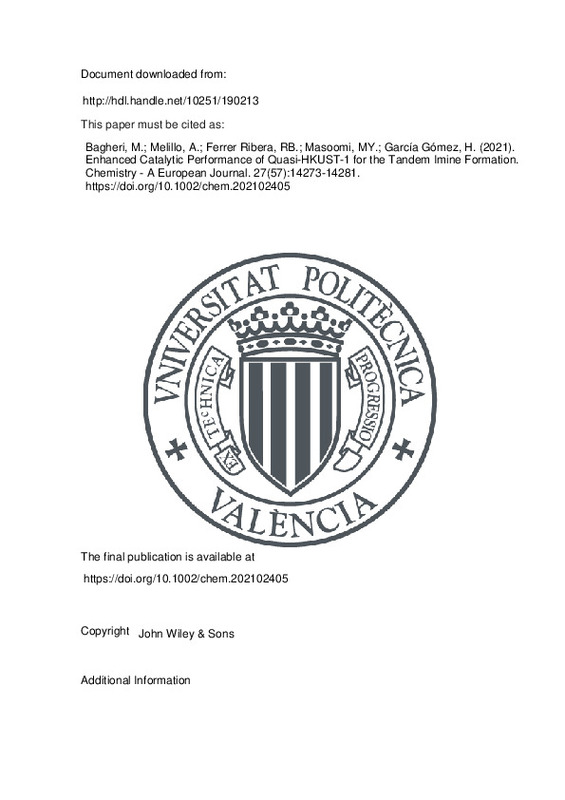JavaScript is disabled for your browser. Some features of this site may not work without it.
Buscar en RiuNet
Listar
Mi cuenta
Estadísticas
Ayuda RiuNet
Admin. UPV
Enhanced Catalytic Performance of Quasi-HKUST-1 for the Tandem Imine Formation
Mostrar el registro sencillo del ítem
Ficheros en el ítem
| dc.contributor.author | Bagheri, Minoo
|
es_ES |
| dc.contributor.author | Melillo, Arianna
|
es_ES |
| dc.contributor.author | Ferrer Ribera, Rosa Belén
|
es_ES |
| dc.contributor.author | Masoomi, Mohammad Yaser
|
es_ES |
| dc.contributor.author | García Gómez, Hermenegildo
|
es_ES |
| dc.date.accessioned | 2022-11-25T19:02:16Z | |
| dc.date.available | 2022-11-25T19:02:16Z | |
| dc.date.issued | 2021-10-13 | es_ES |
| dc.identifier.issn | 0947-6539 | es_ES |
| dc.identifier.uri | http://hdl.handle.net/10251/190213 | |
| dc.description.abstract | [EN] Copper-based metal-organic framework (Cu3 (BTC)2 (H2 O)3 ]n ¿nH2 OMeOH (HKUST-1) has been subjected to thermolysis under air atmosphere at different temperatures ranging from 100 to 300 °C. This treatment produces the partial removal of ligands, the generation of structural defects and additional porosity in a controlled way. The resulting defective materials denoted according to the literature as quasi-MOFs, were subsequently employed as heterogeneous catalysts in the one pot synthesis of N-benzylideneaniline from aniline and benzyl alcohol in open air as terminal oxidant at 70 °C under base- and dehydrating agent-free conditions. The Q-HKUST catalysts calcined at 240 °C (QH-240) was the most efficient in the series, promoting imine synthesis. Data from Knoevenagel condensation of malononitrile shows that in QH-240 the distances of Cu ions in HKUST-1 cavities are preserved, increasing the Knoevenagel activity, but a strong rearrangement takes place at 300 °C or above. The unsaturated copper active sites with simultaneous presence of micro- and mesopores in QH-240 are responsible for this excellent catalytic performance. The effective parameters on catalytic activity of QH-240 including deligandation temperature, the amount of catalyst, the ratio of reactants, and reaction temperature as well as the stability and recyclability of the catalyst were also investigated. The possible mechanism used by QH-240 follows alcohol aerobic oxidation and subsequent anaerobic condensation of aldehyde intermediate with aniline. | es_ES |
| dc.description.sponsorship | Support of this investigation by Arak University and Iran Science Elites Federation are gratefully acknowledged. | es_ES |
| dc.language | Inglés | es_ES |
| dc.publisher | John Wiley & Sons | es_ES |
| dc.relation.ispartof | Chemistry - A European Journal | es_ES |
| dc.rights | Reserva de todos los derechos | es_ES |
| dc.subject | Imine formation | es_ES |
| dc.subject | Partial deligandation | es_ES |
| dc.subject | Pore engineering | es_ES |
| dc.subject | Quasi metal-organic frameworks | es_ES |
| dc.subject | Tandem catalysis | es_ES |
| dc.subject.classification | QUIMICA ORGANICA | es_ES |
| dc.title | Enhanced Catalytic Performance of Quasi-HKUST-1 for the Tandem Imine Formation | es_ES |
| dc.type | Artículo | es_ES |
| dc.identifier.doi | 10.1002/chem.202102405 | es_ES |
| dc.rights.accessRights | Abierto | es_ES |
| dc.contributor.affiliation | Universitat Politècnica de València. Escuela Técnica Superior de Ingenieros Industriales - Escola Tècnica Superior d'Enginyers Industrials | es_ES |
| dc.contributor.affiliation | Universitat Politècnica de València. Instituto Universitario Mixto de Tecnología Química - Institut Universitari Mixt de Tecnologia Química | es_ES |
| dc.description.bibliographicCitation | Bagheri, M.; Melillo, A.; Ferrer Ribera, RB.; Masoomi, MY.; García Gómez, H. (2021). Enhanced Catalytic Performance of Quasi-HKUST-1 for the Tandem Imine Formation. Chemistry - A European Journal. 27(57):14273-14281. https://doi.org/10.1002/chem.202102405 | es_ES |
| dc.description.accrualMethod | S | es_ES |
| dc.relation.publisherversion | https://doi.org/10.1002/chem.202102405 | es_ES |
| dc.description.upvformatpinicio | 14273 | es_ES |
| dc.description.upvformatpfin | 14281 | es_ES |
| dc.type.version | info:eu-repo/semantics/publishedVersion | es_ES |
| dc.description.volume | 27 | es_ES |
| dc.description.issue | 57 | es_ES |
| dc.identifier.pmid | 34403537 | es_ES |
| dc.relation.pasarela | S\446935 | es_ES |







![[Cerrado]](/themes/UPV/images/candado.png)

